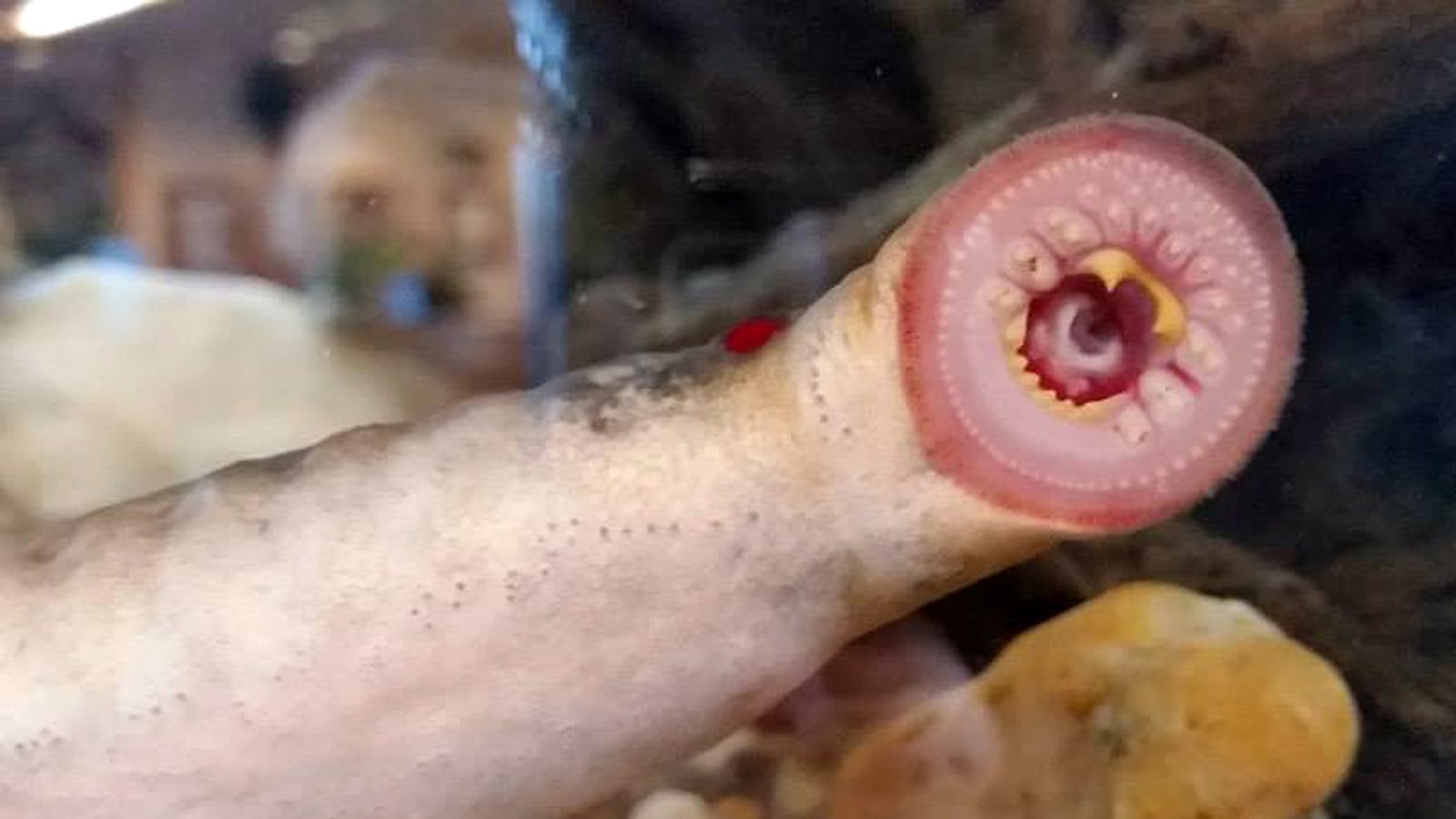It’s not often you see a headline like “Terrifying Vampire Fish Falling from the Sky in Alaska” and can be assured it’s mostly true.
But “vampire fish” is an accurate assessment of what’s going on in towns like Fairbanks, Alaska. Think 30 Days of Night though—not Twilight.
Over the last few weeks Alaskans have reported finding non-glittery fish out of water: cold-blooded, blood-sucking monster fish have literally been falling from the sky, ostensibly swooping in on land-based prey. The creatures in question are actually arctic lampreys, parasitic fish that use several rows of grotesque teeth to latch onto other water-dwellers and suck their blood.
The Alaska Department of Fish and Game posted photos of the foot-long eel creatures on Facebook, with gaping jaws full of circles of teeth and multiple tongues—like infant version of the Sarlaac pit.
They’re scary enough in their Arctic habitat, where they survive by latching onto larger fish, sucking blood until engorged, and then detaching—sometimes killing their prey in the process.

Luckily there seems to be a less sinister explanation than a sudden mutation or evolutionary leap allowing these giant leaching eels to fly. The Department of Fish and Game seems to agree, given the explanation that they posted on Facebook:
“The answer is probably gulls. Gulls are picking them out of the Chena River with their bills and then dropping the squirming critters while in flight. Arctic lampreys spawn in the Chena River, and live in the mud underwater as juveniles for several years. However, many lifelong Alaskans have never seen one of these fascinating fish up close because their body shape and feeding habits make them difficult to catch.”
The Department of Fish and Game’s Sportfish Information Officer Nancy Sisinyak confirmed that theory, and explained that it’s not surprising they were dropped. “It’s a common occurrence that birds will drop fish. Most of the time they can hang onto them, but sometimes they just wiggle free and there you have it,” she tells The Daily Beast. “It’s pretty long and skinny a tubular. It’s a heavy load for a seagull especially the ones that get up to 15 inches. And when this thing is writhing around sometimes they do get loose.”
Despite the terrifying appearance of the fish, she says they pose little harm to humans at this point. In more than a decade working in the filed, she’s never heard of a human getting bitten. “I guess it would be possible,” she says. “But not probable.”
If there’s one thing that’s shocking Sisinyak, who’s been looking at vampire fish for years, it’s the sudden national interest—one she thinks has gotten out of hand. “It’s just crazy how this story has really been brought out of proportion,” she says. “We’ve had four reports. And haven’t had any since last week.”
The migration happens every year, and every year the vampire-like creatures rain down on Alaska. “I’ve been working here for 15 years, and I’ve never had a call about a lamprey falling from the sky,” she says.
In fact there are a few things about the lamprey people have been getting wrong. “There’s a picture floating around of a lamprey with holes, and one thing that’s being spread around is that those are marks from a bird’s beak,” says Sisinyak. “And it’s actually part of the fish—it’s where their gills are housed.”
Another theory that doesn’t add up is that the birds were bringing the lampreys in from the ocean. Considering that Fairbanks is 350 miles away from the ocean, it’s highly unlikely. It’s a longer trip up river, as they head to lay eggs. Sisinyak says that spawn “similarly to salmon,” sweep a spot out on the riverbed for their eggs with their tails.
In truth, she thinks all of this attention is probably good for people and for the lamprey. “People who wouldn’t have even known they existed, they’re learning something,” she says. “So that’s good.”
But maybe you shouldn’t rest easy just yet. The parking lot where one of the lampreys was found is a little over a quarter mile from the Chena River, an offshoot of the Tanana River, which is fed by the Yukon. The Yukon feeds directly into the ocean. That total distance is more than 500 miles, though, so even if these things can’t fly they’ve got enough energy to swim 500 miles and then fight/intimidate their way out of the talons of a bird.
Or maybe they’re just not tasty.
That’s assuming the relationship between lamprey and gull is predatory, not a partnership. If they’ve joined forces to coordinate attacks, well—we’ll miss you, Alaska.






